|
|
 |
 |
 |
 |
 |
 |
The Lychakiv Cemetery (Lviv) |
 |
 |
 |
 |
 |
 |
|
|
|
The cemetery gate a century ago.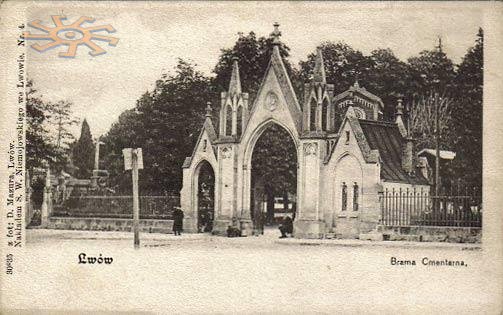 |
Photographed by Andrey Chekmariov (Moscow). The tombstone in the foreground has similar outlines with the monument to Yuriy Dviernytskyi in Lopatyn.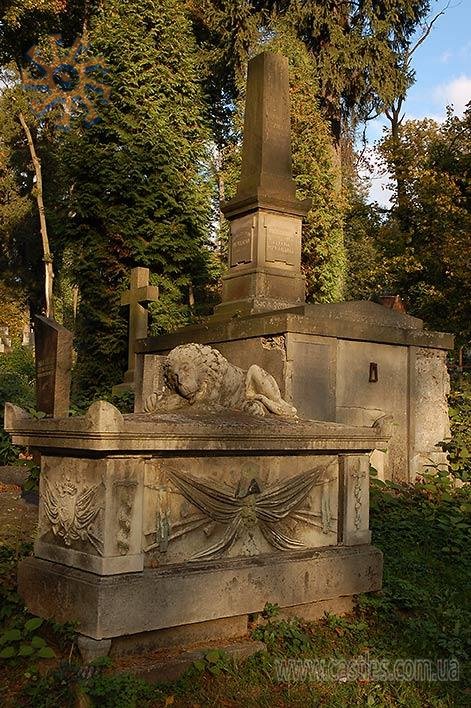 |
Translated by Dictum Factum (Kyiv)
My article for "The Carpathians" magazine (October-November 2006)
Every year hundreds and thousands of tourists visit one of the Europe’s oldest graveyards – Lychakiv Cemetery. And a force that overcomes the fear of death, though obsolete and alien, that urges you to roam in reverie about the cemetery’s alleys examining the gravestones – is the Beauty. 
Design aesthetics were hardly considered in the Lviv City Council in distant 1783 when Emperor Jozef II had ordered to close down all churchyards within Lviv. The order was issued on the basis of the sanitary code valid in the XVIIIth century, the Age of Enlightenment.
Four plots had been allotted on the outskirts of Lviv, which was quite a large city even at that time. The Galician capital was split into districts, where downtown and district IV residents were assigned to the old cemetery in the suburbs of Lychakiv (Ukrainian spelling of Luetzenhof), where people who died of plague where buried in the XVIth century. It was inaugurated in 1786. The then cemetery spanned current plots 6, 7, 9, 10 and 14.
Wealthy residents were living and dying in the City centre. That’s why the Lychakiv cemetery had transformed into the principal necropolis of Lviv. The cemetery has retained this high status till nowadays. Only respected citizens were buried here: priests, politicians and military men. This tradition had lasted up to the post-war period (WWII), when the soviet authorities entitled everyone to be buried at the elite cemetery.
Pillage and vandalism became widespread: the lore of a tycoon’s family buried with golden shoes on tempted looters. The remote area of cemetery was subjected to the most severe ravaging. In the morning, Cemetery workers happened to come across coffins with corpses dumped right on the walks. Whereas fences of the majority of tombs were pillaged by the looters looking for non-ferrous metals.
Let's go back to the earlier times though. “Popularity” of Lychakiv was overwhelming resulting in several expansions of cemetery limits (in 1804, 1808, 1856) - and nowadays it covers 105 acres. By the way, the idea of transforming the Lychakiv Cemetery from the city of dead into a leisure park dates back to 1856, when, Karl Bauer, a university botanist, had rearranged the territory, laid out walks and alleys. Thus the grim kingdom of death gave way to an original park best suited for those feeling blue or romantic. There are a lot of magnificent classicism sculptures carved by Hartmann Witwer, Anton and Johann Schimser, later works by Julian Markowski, Tadeusz Baroncz and Leonard Marconi. 
It’s no surprise if you get lost in Lychakiv. Only a few residents of Lviv can rightfully claim their ability to easily get their bearings around 86 cemetery plots. Initially, the route is quite simple. You have to take a tram #7 or #2 which will take you to Mechnykov Street, enter the neo-Gothic gate erected in 1875 (a cemetery admission fee is to be paid at the entrance) and there will be several alleys. It’s up to you to decide whether to visit the most popular sites or opt for your own route.
A glimpse on posh chapels surrounding the square near the entrance gate (crypts of the Suchodolskis, Kiselkos, Kszeczunowiczs, Adamskis, Morowskis and Lodynskis) – and now you choose where to go.
On the left hand you will see plot 1, sort of a pantheon of the Lviv’s greatest residents, who lived in the nineteenth century. Writers, artists and scientists rest there. Few people know that Ivan Franko was initially buried here, in the Swaczynskis’ crypt. Graves of historian Ivan Krypyakevych (1886-1967) and writer Iryna Wilde (1907-1982) can be found on plot 59 bordering plot 1.
The presence of a pillar with an eagle on top commemorating the rebel, Julian Ordon, designed by Tadeusz Baroncz, also contributed to the tradition to refer to this area of Lychakiv as the Pantheon. Adam Mickiewicz devoted his poem to this hero of the Warsaw’s defence in 1831. Ordon died in 1887 in Florence and his remains were brought to the Lychakiv Cemetery nine years later.
A mason’s sculpture “crushing that granite wall” (plot 5, off the main gate) on the tomb of Ivan Franko created by Serhiy Lytvynenko serves as a perfect landmark.
On the opposite side you will find the monument to Markiyan Shashkevych, “Rouser of Rus”. If you turn to the right from the Franko’s tomb, crossing plot 4 up to plot 57, you will find yourself at the graveyard where rest participants of the Polish Uprising (1830-1831). Moving leftwards from the monument to protopresbyter Gavryil Kostelnyk you will find the oldest burials (plots 6-10) – the realm of priestesses with lacrimarums (ritual vessel for tears) and sad geniuses of death. Moving there you will come across the gothic tombs of Armenian archbishops. Somehow, nowhere else you may find a bigger crowd of tourists armed with cameras.
It seems that plots adjacent to the gate host the highest portion of celebrities. Namely, Volodymyr Ivasyuk, the author of the "Red Rue" song. Maria Konopnytska, a poetess, the author of the popular tale about orphan Marysya. Alexander Czolowski, a historian, director of the Lviv Archive, a legendary figure for the modern regional ethnographers. He proved to be the first to describe the castles of Galicia. Stefan Banach, a math professor. Zygmunt Gorgolewski, architect, designer of the Lviv’s Opera House building. There is story to tell about him.
Gorgolewski was decorated with an order for construction of the Opera house – a unique case for Austria-Hungary. However, the Lviv’s Poltva river encased in an underground concrete tunnel running beneath the magnificent theatre could have ruined the architect’s reputation. The building had sunk 2 feet deep and a wall near the stage had cracked. At that point Gorgolewski suddenly died provoking a surge of rumours. It was said that in fact he had committed suicide fearing that his masterpiece might collapse, thus being incapable to tolerate the disgrace inflicted on him by the Poltva. Later on, it was revealed that these incidents were due to a temporary subsidence affecting the frame. 
Near the entrance you may also find another landmark - the mausoleum of vodka tycoon Józef Adam Baczewski, built in Neo-Renaissance style in 1911. When "The Supplier to the Royal Court" title-holder had fallen fatally ill, he ordered a cunning device from Paris, by the means of which after death…he would be able to reach his destination of eternal rest. It was rumoured that a hearse was trailing behind the deceased and that Baczewski had settled into the coffin only at the cemetery using the same device…
Plot 70 hosts another imposing crypt which was built for Feliks Barczewski by his son Piotr Włodzimierz Probus, the wealthiest man in the Podillya region. This gigantic crypt is nowadays the sole reminder of the family’s once fabulous fortune. Barczewski had bequeathed 700K guldens in cash to charity and science: 50K each were assigned to Lviv and Krakow universities for scholarships, 500K – to an Annual Prize for artistic and historic works, 30K – to poor girls’s dowries, 15K – to students of the Lviv Conservatory and so on. If any patron’s descendant dared to contest the will, he would be immediately deprived of all heirship rights.
Not far from there, there is one of the most poetic tombstones. A sleeping young woman, Józefa Markowska, who died in 1877, attracts eyes and provokes weird narrations where for some reason she is referred to as Barbara and several versions of her demise are voiced. One argues that she was an actress and died on the boards, another one claims that she had poisoned herself on discovery that her sweetheart was betraying her. Whereas Polish sources state that a man, Stanislaw Zborowski, is buried there…
The necropolis hosts more than 300K deceased, 2 thousand crypts and almost 500 sculptures, the majority of which are works of art. The oldest gravestones date back to 1787 and 1797. Genuine masterpieces can be also found among later crypts. Have a look at the long-legged Orpheus made of bronze who is sadly running his fingers over the lyre’s strings (the tombstone of the opera singer Solomiya Krushelnytska). There are unusual tombstones: faithful dogs Pluto and Nero are always on guard by the bust of their owner, doctor Jozef Ivanovycz. There are humble tombs, which, however, tell curious stories, like the tomb of Franciszek Zaremba. This soldier of Kościuszko’s army died aged 112.
Since 1990 Lychakiv Cemetery enjoys the special status of a historical and cultural site. The city of dead, “the population” of which is close to the half million mark, nowadays rarely opens its gates for the “newcomers”. However, there are some exceptions: e.g. remains of Georgiy Gongadze rest there. A crowd of many thousands had paid the last tribute to famous composer Ihor Bilozir by attending his funeral here in 2000.
War memorials deserve special mentioning. There are several: a graveyard of the Red Army soldiers, a memorial to the Ukraine’s National Liberation Struggle neighbouring the so-called "Cemetery of Eaglets' (graves of Polish military men perished in 1918-1920). There are also tombs of people who had fallen victims to the NKVD terror in 1941 (plot 82). 205 Ukrainians, 21 Poles, 6 Germans, 14 Jews and 5 Russians rest in the mass grave. 
Cities of the dead live a life, which is quite similar to the one of the cities of the living. They emerge, live and die. A cemetery operating for more than 2 centuries can be rarely found. Concentration of tombs, fates, legends and miracles may become overwhelming in such place. Here you are, check it out…
Preparing for tests and exams some students attend preparation classes, the others give preference to visiting - Lychakiv Cemetery. Plainly speaking, Mykola Charnetski’s tomb. It is said that during exam sessions cemetery workers had to spill more sand onto the tomb of this Greek Catholic bishop, beatified in 2001, several times. The students were sure that martyr, whose remains were reburied at the Lychakiv Cemetery in 1960s, would definitely help them and that soil from his tomb could work magic. Some sick people shared this belief and were able to identify faultlessly the tomb of Mykola Charnetskyi among thousands of others. Candles were burning twenty-four-hours by the Maltese cross decorated with embroidered towels and pointers were guiding visitors to this humble tomb.
______________________
1: In 1945 Bishop was exiled to the "Siberian labour camps" near Mariinsk, Kemerovo region, then to Vorkuta in the Komi Autonomy. Official records contain evidence that he was subjected to interrogations and tortures, which lasted 600 hours, though the actual duration might be much longer. Taking advantage of the fact that he was fatally ill he was authorised to return to Galicia in 1956 where he secretly resumed preaching. He was referred to as a holy man even before he died. He passed away in 1959 and was buried in Lviv at the Sknyliv Cemetery. In 1960s he was reburied at the Lychakiv Cemetery and on July 4, 2006 – at the temple to Hieromartyr Josafat. 
However, the Lychakiv’s most popular story is about Love. It features Artur Grother (1837-1867), a famous Polish realist artist and Wanda Monne, his fiancée. A cheesy story. An acquaintance at the ball, promenades along the Lychakiv alleys where Arthur had disclosed his desire to be buried there, a naissance of the affection… This affection gave birth to a passionate love. And when poor Hrother died of tuberculosis in France where he had gone in order, like we say today, “to earn a living”, 17-year old Wanda sold her jewellery to bring a coffin with her loved one from Pere Lachaise back to Lviv. A girl also had certain painting skills and famous sculptor Paris Filippi had carved a tomb monument to Hrother on the basis of her sketches. However, he refused to accept the remuneration. Wanda went on to create a locket carrying the portrait of her loved one. The statue of a mourning girl is surrounded by the modern standard tombstones. Nonetheless, tourists, especially from Poland, manage to identify the tomb and bring fresh flowers.
Lychakiv Cemetery also hosts a humble tombstone carrying inscription “Wanda Monne (1850-1923)”. The guides are abusing this storyline by bringing in ghosts of Arthur and Wanda seen by an occasional passer-by in the moonlit nights. A love story lacking a happy-end is well suited for that kind of a posthumous sequel. 
Photographed by Andrey Chekmariov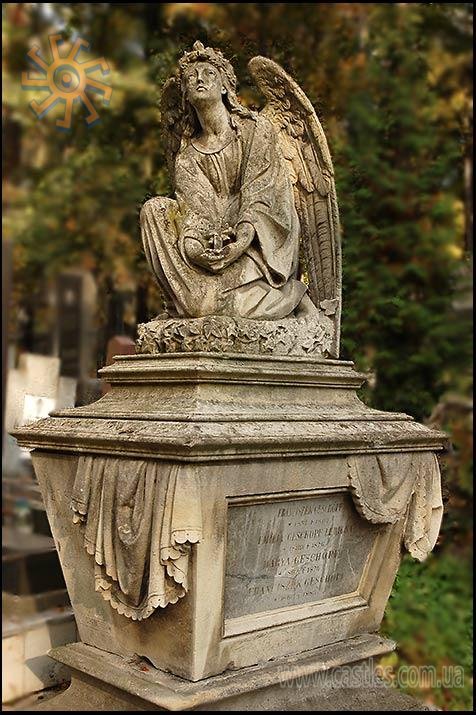 |
|
|

|

 |
 |
 |
 |
 |
At the age of 11 I had almost fallen in love with Orpheus carved by Theodozia Bryzh (tomb of Solomiya Krushelnytska)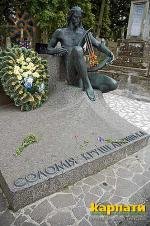 |
The cemetery of Lviv’s defenders in 1930s |
The Lychakiv Cemetery |
Two views on the monument to American pilots |
Tombs of the French |
This tombstone Armenian Archbishop Stefanovych had ordered himself before his death.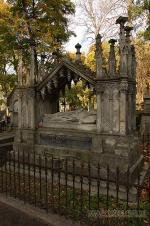 |
|
 |
 |
 |
 |
 |
 |
 |
 |
|
|

